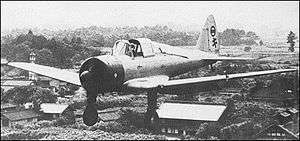Tachikawa Ki-55
| Ki-55 | |
|---|---|
 | |
| Role | Military advanced training aircraft |
| Manufacturer | Tachikawa Aircraft Company |
| First flight | September 1939 |
| Retired | 1945 (Japan) 1953 (China) |
| Primary users | Imperial Japanese Army Air Force Royal Thai Air Force |
| Produced | 1940 - 1943 |
| Number built | 1,389 |
| Developed from | Tachikawa Ki-36 |
Design and development
The excellent characteristics of the Tachikawa Ki-36 made it potentially ideal as a trainer. This led to the development of the Ki-55 with a single machine gun. After successful testing of a prototype in September 1939, the type was put into production as the Army Type 99 Advanced Trainer.
In all 1,389 Ki-55 were constructed before production ended in December 1943 with Tachikawa having built 1078 and Kawasaki 311.[1]
Both the Ki-55 and the Ki-36 were given the Allied nickname 'Ida.'
Variants
- Ki-36 : Army cooperation aircraft.
- Ki-72 : An evolved version with a 600-hp (447-kW) Hitachi Ha-38 engine and retractable undercarriage. Not built.
Operators

- Kumagaya Army Flying School
- Mito Army Flying School
- Tachiarai Army Flying School
- Utsonomiya Army Flying School
- National Government of China Air Force received several from the Japanese.
- Republic of China Air Force operated captured aircraft.
- People's Liberation Army Air Force operated more than 30 captured aircraft at the end of 1945. These Ki-55s were used until the last 14 retired in 1953.
Francillon also mentions delivery to the Japanese satellite air force of Cochinchina, the southernmost third part of present Vietnam[2]
Specifications (Ki-55)
Data from Japanese Aircraft of the Pacific War[3]
General characteristics
- Crew: two
- Length: 8.00 m (25 ft 3 in)
- Wingspan: 11.80 m (38 ft 8.5 in)
- Height: 3.64 m (11 ft 11.25 in)
- Wing area: 20 m2 (215.29 ft2)
- Empty weight: 1,292 kg (2,847 lb)
- Loaded weight: 1,721 kg (3,794 lb)
- Max. takeoff weight: 1,721 kg (3,793 lb)
- Powerplant: 1 × Hitachi Ha13a (Army Type 98 450hp Air Cooled Radial) nine cylinder air-cooled radial engine, 380 kW (510 hp) at take-off
Performance
- Maximum speed: 349 km/h (217 mph)
- Cruise speed: 235 km/h (146 mph)
- Range: 1,060 km (659 mi)
- Service ceiling: 8,150 m (26,740 ft)
- Wing loading: 86.1 kg/m2 (17.6 lb/ft2)
- Power/mass: kW/kg (hp/lb)
Armament
one fixed, forward-firing 7.7mm (0.303in) Type 89 machine gun
See also
Related development
Related lists
References
| Wikimedia Commons has media related to Tachikawa Ki-55. |
- Notes
- ↑ Francillon 1979, p. 254.
- ↑ Francillon 1979, p. 252.
- ↑ Francillon 1979, p. 253.
- Bibliography